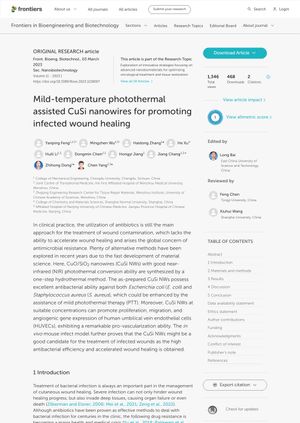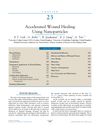Mild-Temperature Photothermal Assisted CuSi Nanowires for Promoting Infected Wound Healing
March 2023
in “
Frontiers in Bioengineering and Biotechnology
”
copper oxide silica CuSi nanowires near-infrared photothermal properties NIR hydrothermal reaction Human Umbilical Vein Endothelial Cells HUVECs gram-positive bacteria S.aureus gram-negative bacteria E.coli collagen deposition neovascularization antibacterial efficiency bioactivity of angiogenesis nanotoxicity near-infrared Staphylococcus aureus Escherichia coli collagen new blood vessels antibacterial angiogenesis

TLDR CuSi nanowires with NIR photothermal properties could effectively treat infected wounds and promote healing.
The study explored the use of copper oxide/silica (CuSi) nanowires with near-infrared (NIR) photothermal properties for treating infected wounds. The nanowires, prepared using a modified hydrothermal reaction method, were about 10 nm in diameter and 600 nm in length. They showed a broad absorption from the wavelength of 400 nm to 1,000 nm and a rapid increase in temperature under 808 nm laser irradiation. The CuSi nanowires were found to promote the proliferation, migration, and pro-vascularization of Human Umbilical Vein Endothelial Cells (HUVECs). They also demonstrated broad antibacterial ability against both gram-positive (S.aureus) and gram-negative (E.coli) bacteria. In a mouse model, the nanowires facilitated wound healing, stimulated less granulation tissue, promoted more collagen deposition, and observed more neovascularization compared to the control group. The study concluded that CuSi nanowires might be a good candidate for the treatment of infected wounds due to their high antibacterial efficiency and bioactivity of angiogenesis. However, further research is needed to address potential risks and limitations, including the stability of CuSi nanowires suspension, potential nanotoxicity, and the need for more biosafety analysis.
